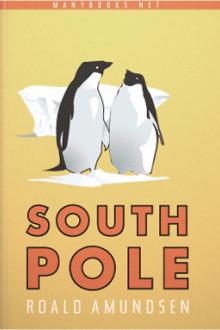A Book of Discovery by M. B. Synge (the snowy day read aloud txt) 📕

- Author: M. B. Synge
- Performer: -
Book online «A Book of Discovery by M. B. Synge (the snowy day read aloud txt) 📕». Author M. B. Synge
On the last day of November, Cook discovered the island of Owhyhee (Hawaii), which he carefully surveyed, till he came to anchor in Karakakooa Bay.
The tragic death of Captain Cook at the hands of these natives is well known to every child. The reason for his murder is not entirely understood to-day, but the natives, who had hitherto proved friendly, suddenly attacked the English explorer and slew him, and "he fell into the water and spoke no more."
CAPTAIN COOK, THE DISCOVERER OF THE SANDWICH ISLANDS CAPTAIN COOK, THE DISCOVERER OF THE SANDWICH ISLANDS, WITH HIS SHIPS IN KEALAKEKUA BAY, HAWAII, WHERE HE WAS MURDERED.From an engraving in the Atlas to Cook's Voyages, 1779.
Such was the melancholy end of England's first great navigator—James Cook—the foremost sailor of his time, the man who had circumnavigated New Zealand, who had explored the coast of New South Wales, named various unknown islands in the Pacific Ocean, and discovered the Sandwich Islands. He died on 14th February 1779. It was not till 11th January 1780 that the news of his death reached London, to be recorded in the quaint language of the day by the London Gazette.
"It is with the utmost concern," runs the announcement, "that we inform the Public, that the celebrated Circumnavigator, Captain Cook, was killed by the inhabitants of a new-discover'd island in the South Seas. The Captain and crew were first treated as deities, but, upon their revisiting that Island, hostilities ensued and the above melancholy scene was the Consequence. This account is come from Kamtchatka by Letters from Captain Clerke and others. But the crews of the Ships were in a very good state of health, and all in the most desirable condition. His successful attempts to preserve the Healths of his Crews are well known, and his Discoveries will be an everlasting Honour to his Country."
Cook's First Voyages were published in 1773, and were widely read, but his account of the new country did not at once attract Europeans to its shores. We hear of "barren sandy shores and wild rocky coast inhabited by naked black people, malicious and cruel," on the one hand, "and low shores all white with sand fringed with foaming surf," with hostile natives on the other.
The world as known after the voyages of Captain Cook (1768-1779) "THE UNROLLING OF THE CLOUDS"—VI.The world as known after the voyages of Captain Cook (1768-1779).
It was not till eighteen years after Cook's death that Banks—his old friend—appealed to the British Government of the day to make some use of these discoveries. At last the loss of the American colonies in 1776 induced men to turn their eyes toward the new land in the South Pacific. Banks remembered well his visit to Botany Bay with Captain Cook in 1770, and he now urged the dispatch of convicts, hitherto transported to America, to this newly found bay in New South Wales.
So in 1787 a fleet of eleven ships with one thousand people on board left the shores of England under the command of Captain Phillip. After a tedious voyage of thirty-six weeks, they reached Botany Bay in January 1788.
Captain Phillip had been appointed Governor of all New South Wales, that is from Cape York to Van Diemen's Land, still supposed to be part of the mainland. But Phillip at once recognised that Botany Bay was not a suitable place for a settlement. No white man had described these shores since the days of Captain Cook. The green meadows of which Banks spoke were barren swamps and bleak sands, while the bay itself was exposed to the full sweep of violent winds, with a heavy sea breaking with tremendous surf against the shore.
"Warra, warra!" (begone, begone), shouted the natives, brandishing spears at the water's edge as they had done eighteen years before. In an open boat—for it was midsummer in these parts—Phillip surveyed the coast; an opening marked Port Jackson on Cook's chart attracted his notice and, sailing between two rocky headlands, the explorer found himself crossing smooth, clear water with a beautiful harbour in front and soft green foliage reaching down to the water's edge. Struck with the loveliness of the scene, and finding both wood and water here, he chose the spot for his new colony, giving it the name of Sydney, alter Lord Sydney, who as Home Secretary had appointed him to his command.
PORT JACKSON AND SYDNEY COVE PORT JACKSON AND SYDNEY COVE A FEW YEARS AFTER COOK AND PHILLIP.From the Atlas to the Voyage de l'Astrolabe.
"We got into Port Jackson," he wrote to Lord Sydney, "early in the afternoon, and had the satisfaction of finding the finest harbour in the world, in which a thousand sail of the line may ride in perfect security."
"To us," wrote one of his captains, "it was a great and important day, and I hope will mark the foundation of an empire."
But, interesting as it is, we cannot follow the fortunes of this first little English colony in the South Pacific Ocean.
The English had not arrived a day too soon. A few days later the French explorer, La Perouse, guided hither by Cook's chart, suddenly made his appearance on the shores of Botany Bay. The arrival of two French men-of-war caused the greatest excitement among the white strangers and the black natives.
La Perouse had left France in 1785 in command of two ships with orders to search for the North-West Passage from the Pacific side—a feat attempted by Captain Cook only nine years before—to explore the China seas, the Solomon Islands, and the Terra Australis. He had reached the coast of Alaska in June 1786, but after six weeks of bad weather he had crossed to Asia in the early part of the following year.
Thence he had made his way by the Philippine Islands to the coasts of Japan, Korea, and "Chinese Tartary." Touching at Quelpart, he reached a bay near our modern Vladivostock, and on 2nd August 1787 he discovered the strait that bears his name to-day, between Saghalien and the North Island of Japan. Fortunately, from Kamtchatka, where he had landed, he had sent home his journals, notes, plans, and maps by Lesseps—uncle of the famous Ferdinand de Lesseps of Suez Canal fame.
On 26th January 1788 he landed at Botany Bay. From here he wrote his last letter to the French Government. After leaving this port he was never seen again. Many years later, in 1826, the wreck of his two ships was found on the reefs of an island near the New Hebrides.
Perhaps one of the strangest facts in the whole history of exploration is that Africa was almost an unknown land a hundred years ago, and stranger still, that there remains to-day nearly one-eleventh of the whole area still unexplored. And yet it is one of the three old continents that appear on every old chart of the world in ancient days, with its many-mouthed Nile rising in weird spots and flowing in sundry impossible directions. Sometimes it joins the mysterious Niger, and together they flow through country labelled "Unknown" or "Desert" or "Negroland," or an enterprising cartographer fills up vacant spaces with wild animals stalking through the land.
The coast tells a different tale. The west shores are studded with trading forts belonging to English, Danes, Dutch, and Portuguese, where slaves from the interior awaited shipment to the various countries that required negro labour. The slave trade was the great, in fact the only, attraction to Africa at the beginning of the eighteenth century. In pursuit of this, men would penetrate quite a long way into the interior, but through the long centuries few explorers had travelled to the Dark Continent.
Towards the end of the century we suddenly get one man—a young Scottish giant, named James Bruce, thirsting for exploration for its own sake. He cared not for slaves or gold or ivory. He just wanted to discover the source of the Nile, over which a great mystery had hung since the days of Herodotus. The Mountains of the Moon figure largely on the Old World maps, but Bruce decided to rediscover these for himself. Herodotus had said the Nile turned west and became the Niger, others said it turned east and somehow joined the Tigris and Euphrates. Indeed, such was the uncertainty regarding its source that to discover the source of the Nile seemed equivalent to performing the impossible.
James Bruce, athletic, daring, standing six feet four, seemed at the age of twenty-four made for a life of travel and adventure. His business took him to Spain and Portugal. He studied Arabic and the ancient language of Abyssinia. He came under the notice of Pitt, and was made consul of Algiers. The idea of the undiscovered sources of the Nile took strong hold of Bruce's imagination.
"It was at this moment," he says, "that I resolved that this great discovery should either be achieved by me or remain—as it has done for three thousand years—a defiance to all travellers."
A violent dispute with the old bey of Algiers ended Bruce's consulate, and in 1765, the spirit of adventure strong upon him, he sailed along the North African coast, landed at Tunis, and made his way to Tripoli. On the frontier he found a tribe of Arabs set apart to destroy the lions which beset the neighbourhood. These people not only killed but ate the lions, and they prevailed on Bruce to share their repast. But one meal was enough for the young explorer.
In burning heat across the desert sands he passed on. Once a great caravan arrived, journeying from Fez to Mecca, consisting of three thousand men with camels laden with merchandise. But this religious pilgrimage was plundered in the desert soon after. Arrived at Bengazi, Bruce found a terrible famine raging, so he embarked on a little Greek ship bound for Crete. It was crowded with Arabs; the captain was ignorant; a violent storm arose and, close to Bengazi, the ship struck upon a rock. Lowering a boat, Bruce and a number of Arabs sprang in and tried to row ashore. But wave after wave broke over them, and at last they had to swim for their lives. The surf was breaking on the shore, and Bruce was washed up breathless and exhausted. Arabs flocking down to plunder the wreck, found Bruce, and with blows and kicks stripped him of all his clothes and left him naked on the barren shore. At last an old Arab came along, threw a dirty rag over him, and led him to a tent, whence he reached Bengazi once more, and soon after crossed to Crete.
A NILE BOAT, OR CANJA A NILE BOAT, OR CANJA.From Bruce's Travels to Discover the Source of the Nile.
It was not till July 1768 that the explorer at last reached Cairo en route for Abyssinia, and five months later embarked on board a Nile boat, or canja. His cabin had close latticed windows made not only to admit fresh air, but to be a defence against a





Comments (0)